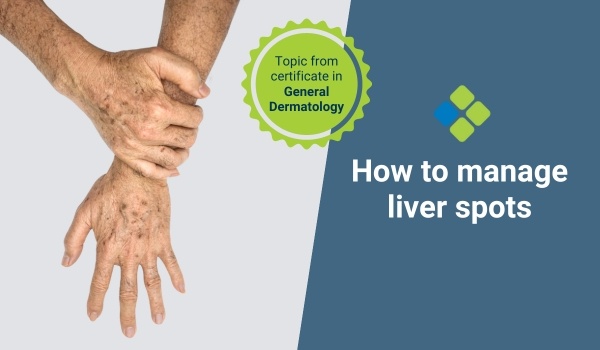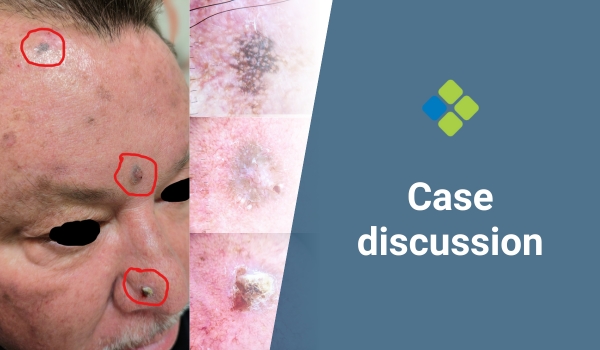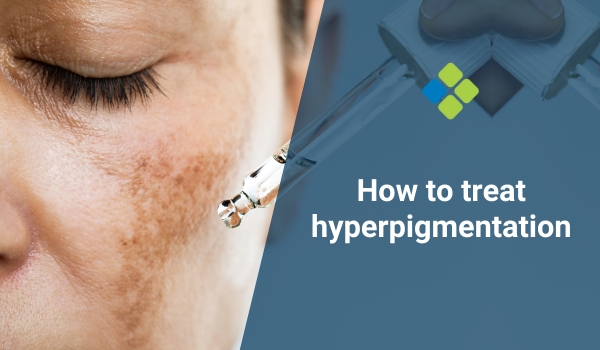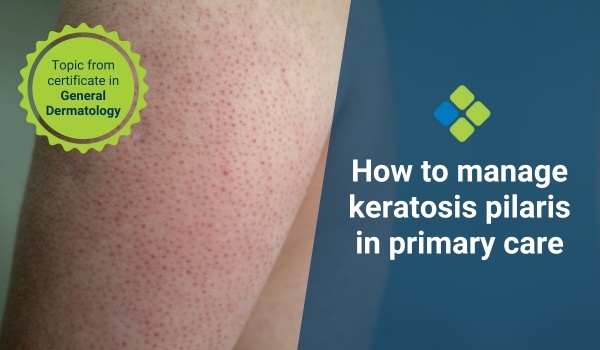How to manage liver spots
Read about the management of liver spots (solar lentigines, age spots) in primary care, including patient education, prevention, and treatment options.

HealthCert Education
Liver spots, age spots, or solar lentigines, are common skin lesions that appear on sun-exposed parts of the skin. Areas of the body usually affected include the face, hands, shoulders, and arms.
These changes are usually harmless, but they can be a cosmetic concern for many patients. Effective management of liver spots in primary care involves a comprehensive approach that includes patient education, preventive measures, and treatment options.
How to recognise liver spots
Liver spots are flat, brown, black, or gray patches on the skin. They are caused by an excess production of melanin, often due to prolonged exposure to ultraviolet (UV) radiation from the sun or tanning beds. Age is a significant factor, as these spots are more common in individuals over 50.
Initial assessment
When a patient presents with liver spots, the primary care provider should:
Perform a thorough history and physical examination
This includes assessing the duration, progression, and potential changes in the spots. A doctor should also ask about sun exposure history, use of tanning beds, and sunscreen habits. The review of the patient's medical history should focus on potential pre-existence of skin cancer or precancerous lesions.
Differentiate from other lesions
When available, dermoscopy is the best method to differentiate liver spots from other pigmented lesions such as moles, seborrheic keratosis, and malignant melanoma. Nevertheless, a primary care doctor should look for irregular borders, colour variation, or rapid changes, which may warrant a biopsy to rule out malignancy.
Educate patients and inform then about preventive measures
Educating patients is crucial in managing liver spots and preventing further skin damage. Key points include:
- Regular use of broad-spectrum sunscreen with an SPF of 30 or higher, even on cloudy days
- Wearing protective clothing, hats, and sunglasses
- Seeking shade during peak UV hours (10 a.m. to 4 p.m.)
- Avoiding the use of tanning beds
- Performing self-examinations and reporting any new or changing lesions
Treatments options for liver spots
Treatment is typically sought for cosmetic reasons. Options include:
Topical treatments
- Hydroquinone, a bleaching agent that can lighten liver spots. It is often used in combination with tretinoin and a mild steroid to enhance effectiveness.
- Retinoids (tretinoin, adapalene) can help to promote cell turnover and improve skin texture.
- Other agents, such as Azelaic acid and kojic acid are alternative topical treatments with skin-lightening properties.
Procedural interventions
- Cryotherapy - freezing the liver spots with liquid nitrogen can cause the spots to peel off over time.
- Various lasers, such as Q-switched lasers and fractional lasers, can target pigmented cells and reduce the appearance of liver spots.
- Medium to deep chemical peels can exfoliate the skin and reduce pigmentation.
Non-ablative methods
- Intense Pulsed Light (IPL) devices use light energy to target pigmentation without damaging the surface of the skin.
Managing liver spots in primary care involves a balanced approach of preventive education, patient reassurance, and appropriate therapeutic interventions. By emphasising sun protection and offering various treatment options, GPs can help patients manage this common cosmetic concern effectively. Regular follow-ups and patient engagement are key to achieving the best outcomes.
– Dr Rosmy De Barros
For further information on this topic, you may be interested to learn more about the HealthCert online Professional Diploma program in General Dermatology.
Engaging with this blog can help meet your annual
|

How to claim your CPD hoursIf you consume educational webinars, podcasts, articles, or research on this blog, you can Quick Log CPD hours with the RACGP via the usual self-submission process. You will be asked to reflect on what you have learned, and you will require supporting evidence such as a screenshot.Download the RACGP’s guide to self-recording your CPD here. |
Read another article like this one: How to manage heat rash
References
- Nam, H. J., & Chae, B. Y. (1996). Bibliographical Study on Liver Spot. The Journal of Korean Medicine Ophthalmology and Otolaryngology and Dermatology, 9(1), 16-24.
- Prasannan, S., Savitha, A. S., & Nagesh, T. S. (2022). Spots in dermatology. Clinical Dermatology Review, 6(1), 59.
- Rafal, E. S., Griffiths, C. E., Ditre, C. M., Finkel, L. J., Hamilton, T. A., Ellis, C. N., & Voorhees, J. J. (1992). Topical tretinoin (retinoic acid) treatment for liver spots associated with photodamage. New England Journal of Medicine, 326(6), 368-374.
- Anderson, R. R., & Parrish, J. A. (1991). Lasers in dermatology. In Optronic Techniques in Diagnostic and Therapeutic Medicine(pp. 213-226). Boston, MA: Springer US.

 1800 867 1390
1800 867 1390






